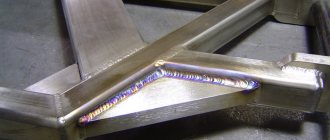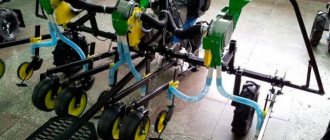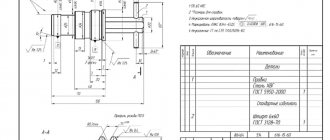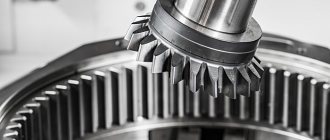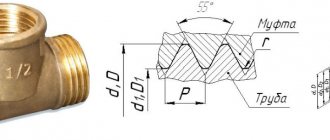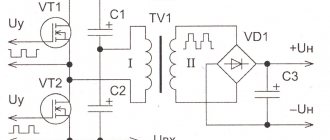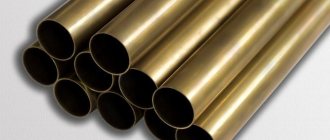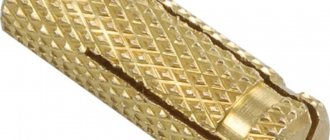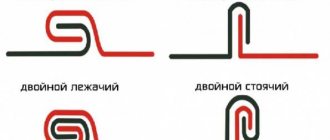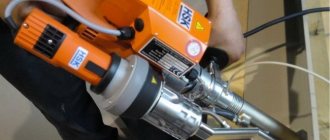The concept of tolerances
Tolerance is the difference between the maximum and minimum permissible dimensions of a part. When making any product, it is impossible to achieve an exact size. The equipment does not allow this. In addition, there are no instruments that could measure the size with great accuracy. But often this is not necessary. Parts manufactured with errors can also be used. The main thing is that their sizes do not go beyond the permissible limits.
It all depends on the task at hand. Complex instruments used in metrology require high-quality manufacturing of components. Simple products, such as teapots or pots, are made with less precision.
Drilling on the jig
To guide the cutting tool and fix the workpiece according to the requirements of the technological process, various jigs are used. Constant mounting bases of the device and jig bushings that provide direction to the drill increase the accuracy of processing. When drilling along a jig, the driller performs several simple techniques (installs the jig, the workpiece and removes them, turns the spindle feed on and off).
Drilling through and blind holes. There are mainly two types of holes in workpieces: through holes, passing through the entire thickness of the part, and blind holes, drilled only to a certain depth.
The process of drilling through holes is different from the process of drilling blind holes. When drilling through holes, when the drill comes out of the hole, the resistance of the workpiece material decreases abruptly. If you do not reduce the feed speed of the drill at this time, it may become jammed and break. This happens especially often when drilling holes in thin workpieces, through intermittent holes and holes located at right angles to one another. Therefore, drilling a through hole is carried out with a high mechanical feed speed of the spindle. At the end of drilling, you need to turn off the feed speed and drill the hole manually at a speed lower than mechanical.
When drilling with manual tool feed, the feed speed before the drill leaves the hole should also be reduced somewhat, drilling should be done smoothly.
There are three main methods of drilling blind holes.
If the machine on which a blind hole is drilled has any device for automatically turning off the spindle feed speed when the drill reaches a given depth (reading rulers, dials, hard stops, automatic stops, etc.), then when setting up to perform this operation it is necessary to adjust to the specified drilling depth.
If the machine does not have such devices, then to determine the achieved drilling depth, you can use a special chuck (Fig. 6.22, a) with an adjustable stop. The thrust sleeve 2 of the chuck can be moved and installed relative to the body 1 with the drill at a given processing depth. The machine spindle moves down until the end of the bushing 2 stops at the end of the jig bushing 3 (when drilling along the jig) or into the surface of the workpiece. This chuck ensures hole depth accuracy within 0.1...0.5 mm.
If greater accuracy of drilling depth is not required and there is no specified chuck, then you can use a stop in the form of a sleeve attached to the drill (Fig. 6.22, b), or mark the depth of the hole on the drill with chalk. In the latter case, the spindle is fed until the drill goes deep into the workpiece to the mark.
The drilling depth of a blind hole is periodically checked with a depth gauge, but this method requires additional time, since you have to remove the drill from the hole, remove the chips and, after measuring, reinsert it into the hole.
Existing terms
In mechanical engineering, a number of terms are used to characterize the size of a part. Based on the material from the textbooks, they have the following names:
- Nominal value. The zero line relative to which deviations are measured.
- Real value. Actual part size, taking into account manufacturing errors.
- Upper deviation. The difference between the upper permissible value of the product and the nominal value.
- Lower deviation. The difference between the lower acceptable size and the nominal value.
When designing products, it is necessary to use standard tables of tolerances and fits, which are available in textbooks or reference literature.
Landing options
The definition of fit refers to the nature of the mating of two parts. There are 3 types of such articulation:
- With a gap. In this case, the covering surface is larger than the covered one. The gap is formed due to the fact that the lower deviation of the hole is greater than the upper one near the shaft.
- With tension. The female surface of the hole is smaller than that of the shaft. The connection formed creates a strong connection that simply does not come apart.
- Transitional. With this connection, the articulation between the parts occurs with a slight tension.
All types of plantings find their application in mechanical engineering. When it is necessary to achieve a rigid connection so that one part does not rotate relative to another, interference is applied. Sometimes even this is not enough. To enhance the strength of the connection, parts of the structure are preheated. The resulting fit is called hot-pressed.
Drilling holes
Drilling is a technological operation performed to increase the diameter of previously drilled holes to a certain size. This is done using a larger diameter drill.
In cases where the power of the equipment is not enough to drill large-diameter holes, this operation occurs in several stages. This is when reaming is most often used. It is usually produced when the diameter of the final hole exceeds 25 millimeters.
First, a hole is drilled with a drill whose diameter is equal to half the thickness of the jumper of the second drill, which is subsequently used for drilling. This is necessary in order to significantly reduce the axial pressure on the cutting tool. As for the cutting modes, when drilling they are in most cases the same as when drilling.
Drilling is a technological process for which a special cutting tool is used. With its help, other surfaces of parts are created that have predetermined dimensions, shape and quality.
Hole and shaft system
Based on ESDP standards, landings can take place in two systems. They have their own characteristics:
- Hole system. When forming the joint, the hole remains a constant size, and the shaft is adjusted to fit it.
- Shaft system. In this case, the size of the shaft remains constant, and a hole is formed for it.
In the manufacture of structures, the hole system is more often used . This is due to the simplified process of measuring the outer surface of the shaft. There is a special measuring tool for this.
The shaft system is used in the manufacture of bearings. Their outer surface is the main one; the landing clips are adjusted to it.
Types of holes and methods of processing them
According to the processing methods, holes are divided into:
1) mounting holes,
into which bolts, screws, studs, rivets, etc. are installed. The manufacturing accuracy of such holes usually lies within 11...12 grades and coarser. Such holes are usually drilled on drilling machines;
2) stepped or smooth holes
in details such as bodies of revolution. Such holes are machined with a drill or cutter during turning operations. In some cases, these holes are countersinked or reamed;
3) critical holes
in body parts that determine the performance of machines and mechanisms. Such holes are processed no worse than according to the 7th quality on special or universal machines;
4) deep holes
with a length-to-diameter ratio of more than five ( , processed on special machines;
5) conical and shaped holes,
which are processed with tools with special cutting edges;
6) profile (non-circular) holes,
processed by broaching, stitching or chiselling.
Requirements for holes, depending on their purpose:
— maintaining the size of the hole diameter with a given accuracy;
— straightness of the axis of the hole and the surface forming it;
— correct cylindrical shape of the hole (no taper, ovality, cut);
— perpendicularity of the hole axis to the end surfaces of the part.
The processing of round holes is carried out on a group of universal or special machines that can provide the necessary technological characteristics of the holes.
According to the processing methods, holes are divided into:
1) mounting holes,
into which bolts, screws, studs, rivets, etc. are installed. The manufacturing accuracy of such holes usually lies within 11...12 grades and coarser. Such holes are usually drilled on drilling machines;
2) stepped or smooth holes
in details such as bodies of revolution. Such holes are machined with a drill or cutter during turning operations. In some cases, these holes are countersinked or reamed;
3) critical holes
in body parts that determine the performance of machines and mechanisms. Such holes are processed no worse than according to the 7th quality on special or universal machines;
4) deep holes
with a length-to-diameter ratio of more than five ( , processed on special machines;
5) conical and shaped holes,
which are processed with tools with special cutting edges;
6) profile (non-circular) holes,
processed by broaching, stitching or chiselling.
Requirements for holes, depending on their purpose:
— maintaining the size of the hole diameter with a given accuracy;
— straightness of the axis of the hole and the surface forming it;
— correct cylindrical shape of the hole (no taper, ovality, cut);
— perpendicularity of the hole axis to the end surfaces of the part.
The processing of round holes is carried out on a group of universal or special machines that can provide the necessary technological characteristics of the holes.
Accuracy qualifications
The degree of accuracy for each nominal size can be determined by qualifications. If we list the number, then there are 19 of them. All of them are summarized in a table. As the nominal dimensions increase, the tolerance range expands. This is due to the fact that it is more difficult to produce a large part with tight tolerances than a small one. Qualifications are indicated in Latin letters:
- The hole system uses fractional notation. The numerator is marked with the letter N. It means the main hole. Nearby is the qualification number. The denominator is written in capital Latin letters with the qualification number. They indicate shaft deflection. For example, H7/f6.
- In the shaft system. The denominator contains the letter h with the number of the qualification. It means that the shaft is the main one. The numerator contains capital Latin letters with the qualification number. They indicate the deviation of the hole. For example, R7/h6.
This unification greatly facilitates the work of designers in the process of designing complex products.
When designating landings on drawings, letter designations alone are not enough. The worker making the part must see the magnitude of the tolerances, so numbers of upper and lower deviations are placed next to the letters. All data is taken from the directory.
Tolerances and landings constitute a separate subject in educational institutions. Students and pupils write essays on a topic, which are then read out in classes or lecture halls.
